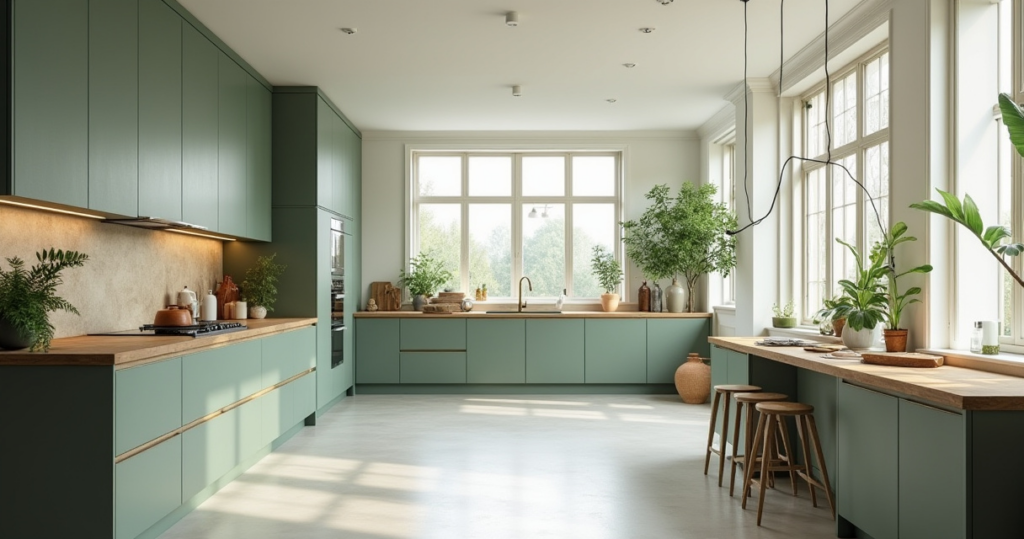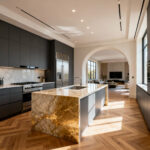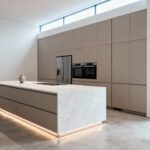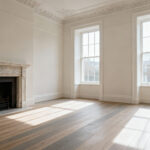Designing a home is fundamentally an act of self-revelation—every choice reflects not just aesthetic preference, but deeper values about how life should be lived. In my culture, the kitchen is the soul of the home, a place of nourishment, stories, and sacred alchemy. The most compelling interiors aren’t decorated; they’re authored. They tell coherent stories about their inhabitants’ journeys, aspirations, and understanding of beauty’s role in daily life. A choice as significant as your cabinetry color is the main character in that story.
These twenty principles separate spaces that feel authentic from those that simply look expensive. We’ll journey from understanding the very soul of green to exploring the hands that can shape it, weaving a symphony of space that feels both contemporary and deeply rooted. We will explore how to select materials with integrity, orchestrate a beautiful play of light and pattern, and finally, live within this creation in a way that allows it to evolve gracefully. This is your guide to crafting a kitchen that isn’t just beautiful, but is a vibrant sanctuary, a true heart for your home.
Embracing Verdant Vibrations: The Psychological & Cultural Resonance of Green in Kitchen Design (Part 1)
Before we even touch a paint swatch, let’s connect with the spirit of green. It’s a color that speaks a universal language of life and tranquility. Here, we’ll decode its whispers—understanding how different shades shape our mood and how to align this powerful hue with your home’s unique story and even your cultural heritage.
1. Decoding the Psychosocial Alchemy of Verdant Tones for Culinary Spaces
Choosing green for your kitchen is an invitation for the soul to breathe. It’s a color woven into the fabric of life itself, from the deep, calming shade of a banyan leaf to the invigorating zest of fresh coriander. Philosophically, these verdant tones connect us to nature and equilibrium, a concept we intuitively crave in our busy lives. This transforms the kitchen from a place of tasks into a restorative haven where you don’t just cook, you create and connect.
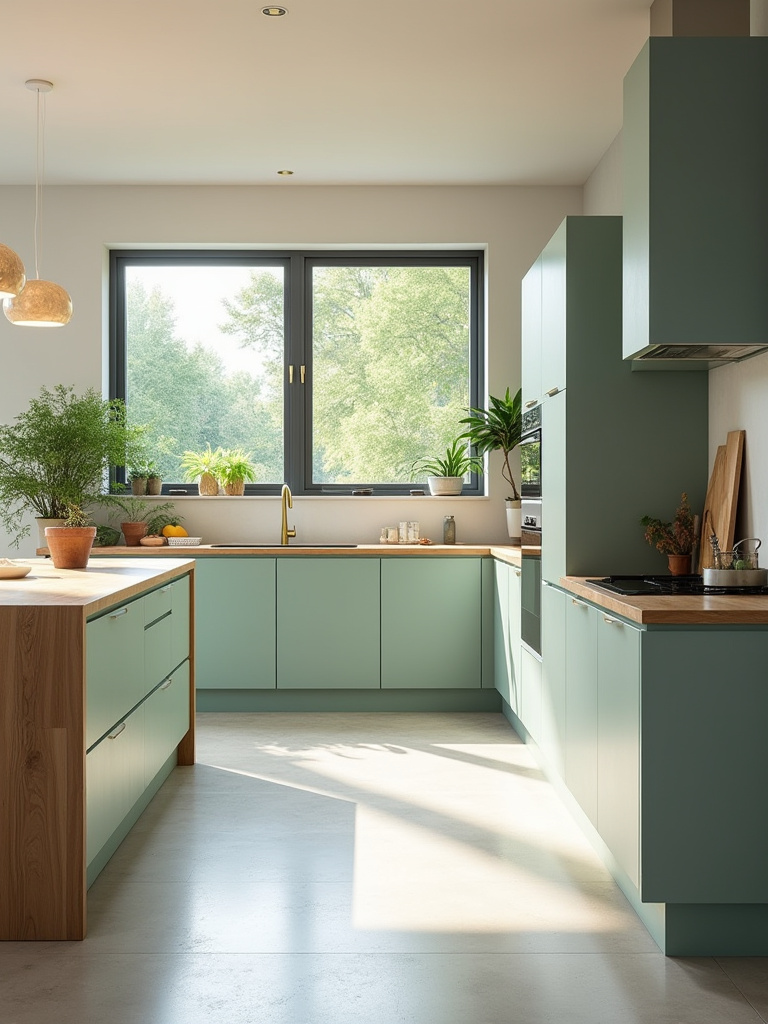
A soft, muted sage can calm a chaotic mind, perfect for preparing mindful, nurturing meals. A vibrant emerald, on the other hand, can feel like a flash of a peacock’s feather—energizing, joyful, and inspiring for the adventurous cook. In my Indo-Contemporary fusion practice, I’ve seen how this choice sets the entire emotional tone of a home. By selecting green for your cabinets, you’re not just picking a color; you are mindfully curating an atmosphere of well-being, growth, and vibrant peace.
2. Calibrating the Hue: Masterminding Your Perfect Green Overtone and Undertone
Simply saying “green” is like saying “spice”—the possibilities are endless and nuanced! The true mastery lies in understanding the subtle play of overtones and undertones that give a green its unique personality. Does your green lean towards the sunny warmth of turmeric (yellow undertones) or the cool depths of the monsoon sky (blue undertones)? This choice will dramatically change how it feels in your space.
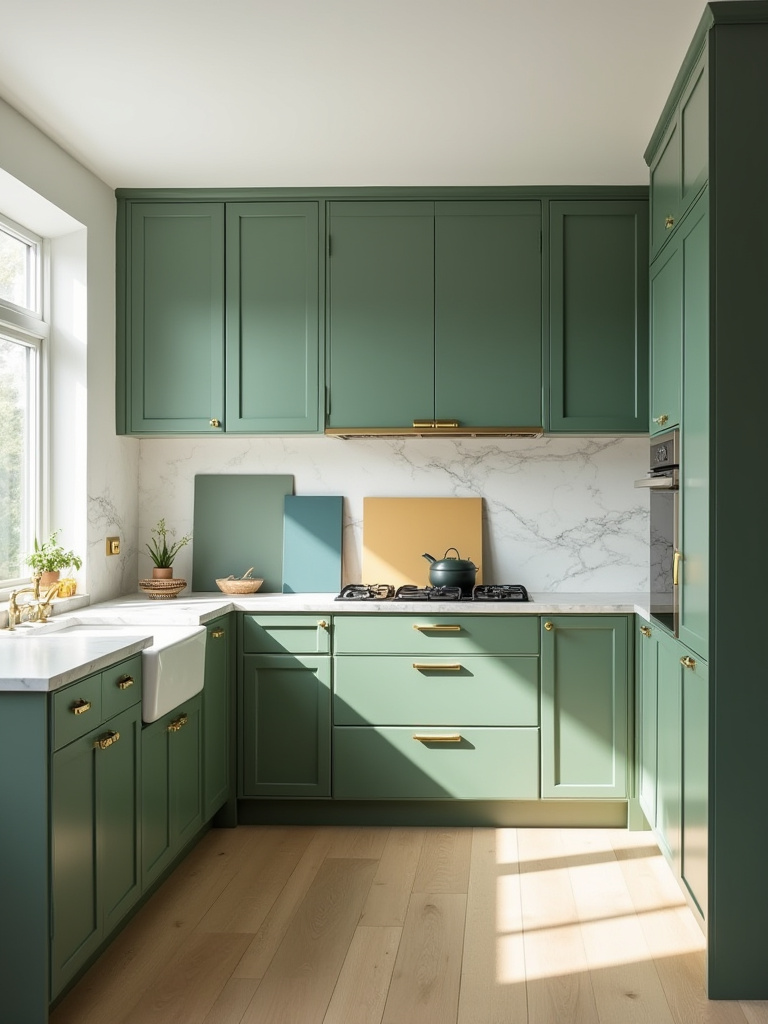
To get it right, you must become a student of your own light. Northern light is cool and ethereal, so it can make a blue-based green feel chilly; here, a warmer, olive-toned green might create better balance. Sunny, southern light can wash out pale greens but will make a deep forest green sing with richness. What I tell my clients is to forget tiny swatches. Paint a large board with your top two choices and live with them for a few days. Watch how they shift from the first morning chai to a softly lit dinner. This is the only way to ensure your cabinets don’t just feature a color, but truly embody a living, breathing hue.
3. Architectural Dialogue: Aligning Green Cabinetry with Existing Home Biographies
Your beautiful green cabinets shouldn’t feel like a stranger in your home; they should feel like they’ve always belonged. Every home has its own story, its own architectural biography, and your design choices should honor that. For a historic home with rich, dark wood and intricate details, a deep, jewel-toned hunter green can feel authentic and regal, speaking the same language of heritage and grace.
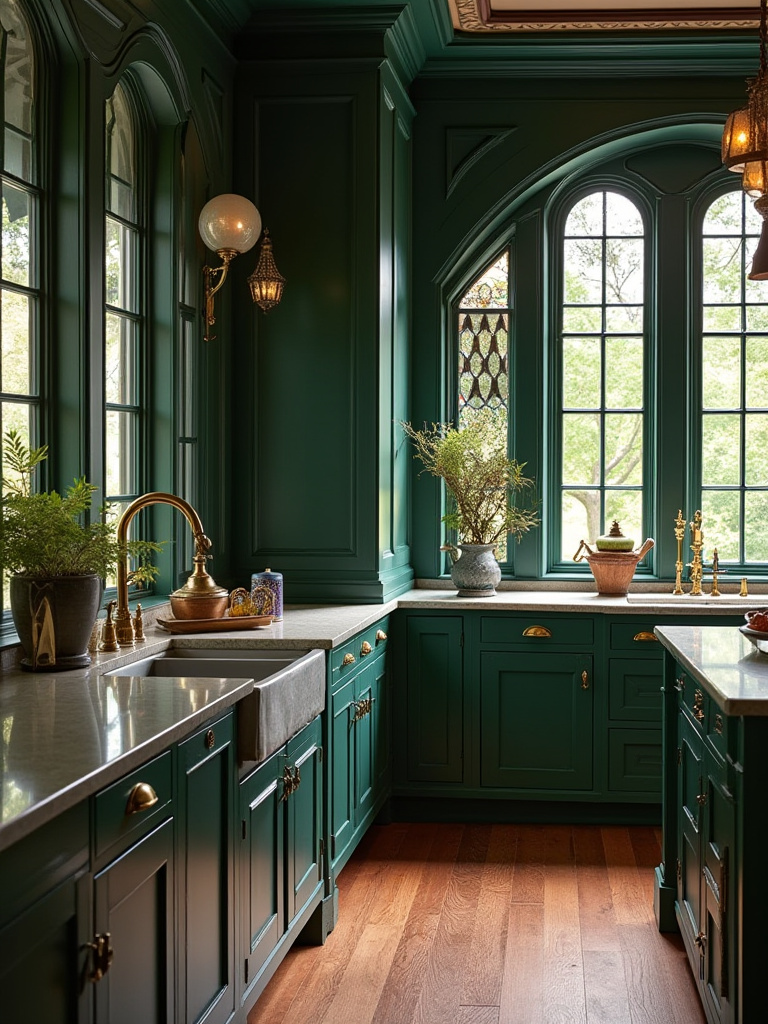
In a minimalist, mid-century modern space defined by clean lines, an avocado or mossy green resonates perfectly with that era’s love for organic forms and natural palettes. It’s not about creating a period replica, but about having an intelligent conversation with the space. For instance, I learned this when working on a project with exposed brick walls—we chose a muted, matte olive green for the cabinets. The soft, earthy green didn’t compete with the rustic brick; instead, it created this wonderfully rich, textural harmony that felt both contemporary and timeless. This is the key: ensuring your kitchen feels like a cohesive chapter in your home’s unique and evolving story.
4. Harvesting Heritage: Infusing Cultural Green Significances into Design Narratives
Green is a color steeped in meaning across the globe, and weaving these cultural significances into your kitchen can make it profoundly personal. This elevates your green kitchen cabinets from a design choice into a symbol of identity, a nod to your roots, or an appreciation for global artistry. In many parts of India and the Islamic world, green is the color of paradise, prosperity, and life itself. Using a shade of emerald can subtly echo these revered traditions, especially when paired with the intricate geometry of Jaali patterns or the warm glow of brass hardware.
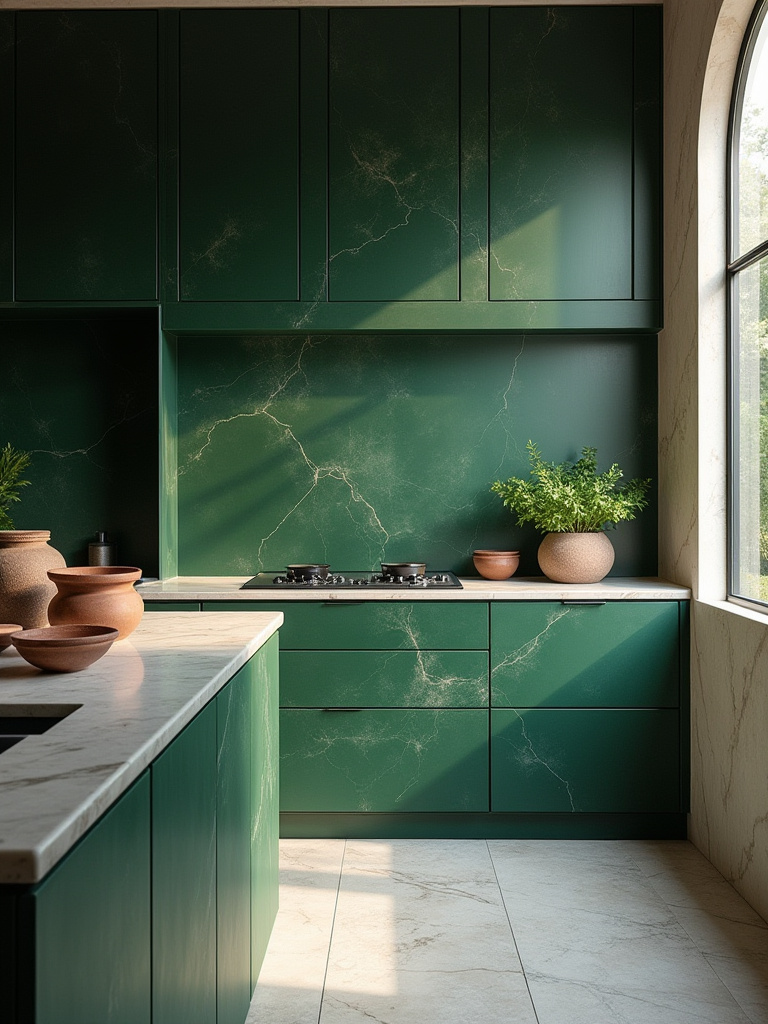
Consider the soft, milky-green of jade, treasured in many Asian cultures as a stone of harmony and good fortune—what a beautiful energy to bring into the heart of your home! Or perhaps your soul connects with the misty, mossy greens of Celtic folklore, linking your kitchen to ancient landscapes and a sense of enduring history. By choosing a green that resonates with a cultural narrative dear to you, your kitchen becomes more than just a place to cook. It becomes a living tapestry, a space that tells a rich, meaningful story every single day.
Embracing Verdant Vibrations: The Psychological & Cultural Resonance of Green in kitchen design (Part 2)
Diving deeper, let’s explore how the color green truly forges a sanctuary. It’s about building a subconscious bridge to the natural world—what designers call a ‘biophilic’ connection. Choosing green kitchen cabinets is the most powerful way to lay the foundation for a space that doesn’t just look good, but feels deeply restorative.
5. The Biophilic Blueprint: Orchestrating a Harmonious Connection to the Natural World
There’s a reason we feel calmer when surrounded by nature. It’s a deep, primal connection scientists call biophilia. Bringing this principle into your kitchen design moves beyond simple decorating; it’s about crafting an environment that satisfies this innate craving for the natural world. Green kitchen cabinets become the cornerstone of this philosophy—the visual anchor that immediately signals life, restoration, and tranquility.
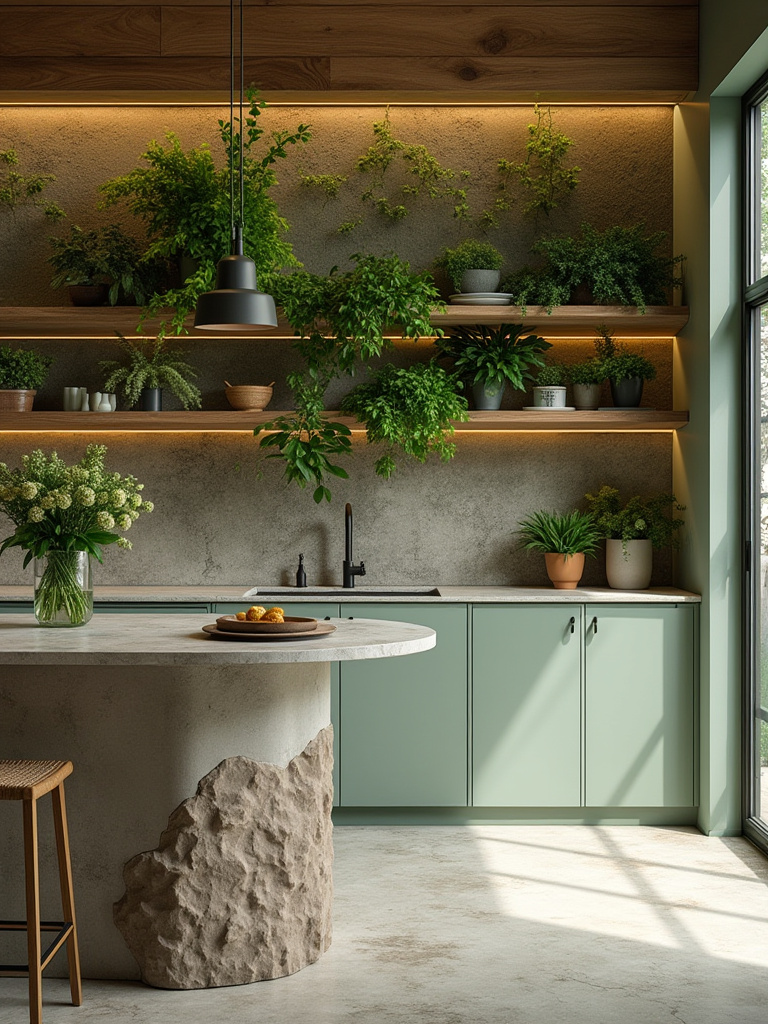
From this philosophical anchor, we explore materials that resonate with nature. Imagine your sage green cabinets complemented by the warm, honest grain of an unstained mango wood shelf or a countertop that echoes the smooth texture of a river stone. Tactile elements like rattan pendants or hand-spun cotton curtains amplify this connection, engaging all your senses. Natural light is your most important collaborator here, breathing life into your chosen green, allowing it to shift and dance throughout the day like light through a forest canopy.
This biophilic approach reshapes the very layout of your kitchen. Perhaps your green kitchen cabinets frame a large window, dissolving the boundary between your garden and your cooking space. An island painted in a deep, earthy green can become a grounding centerpiece, a gathering spot that feels as natural as sitting under a great tree. Open shelves displaying artisanal pottery and living herbs invite a sense of organic, breathing life into the room.
Ultimately, a biophilic kitchen fosters a more mindful lifestyle. Preparing a meal feels less like a chore and more like a nourishing ritual when you’re surrounded by colors and textures that recall growth and organic abundance. By choosing green kitchen cabinets as the heart of a biophilic design, you’re not just picking a color; you are making a profound investment in a calmer, healthier, and more inspiring way of life.
Artisanal Greenscapes: Selecting Sustainable Materials and Finishes (Part 1)
Now we move from the soul of color to the body—the materials themselves. A truly beautiful kitchen has integrity at its core. This means choosing materials that are not only stunning but are also kind to our planet, and finishes that feel as good as they look.
6. Investigating the Ecotone: Prioritizing Sustainably Sourced Wood Species and Engineered Boards
Our exploration of green kitchen cabinets must begin with the very heart of the material: the wood. I believe design carries a responsibility, a dharma, to be in harmony with our world. This means prioritizing sustainably sourced materials, seeking out certifications like FSC that ensure our forests are respected. I’m particularly drawn to reclaimed wood, which brings a beautiful story and soul into a new home, its imperfections telling a tale of a past life.
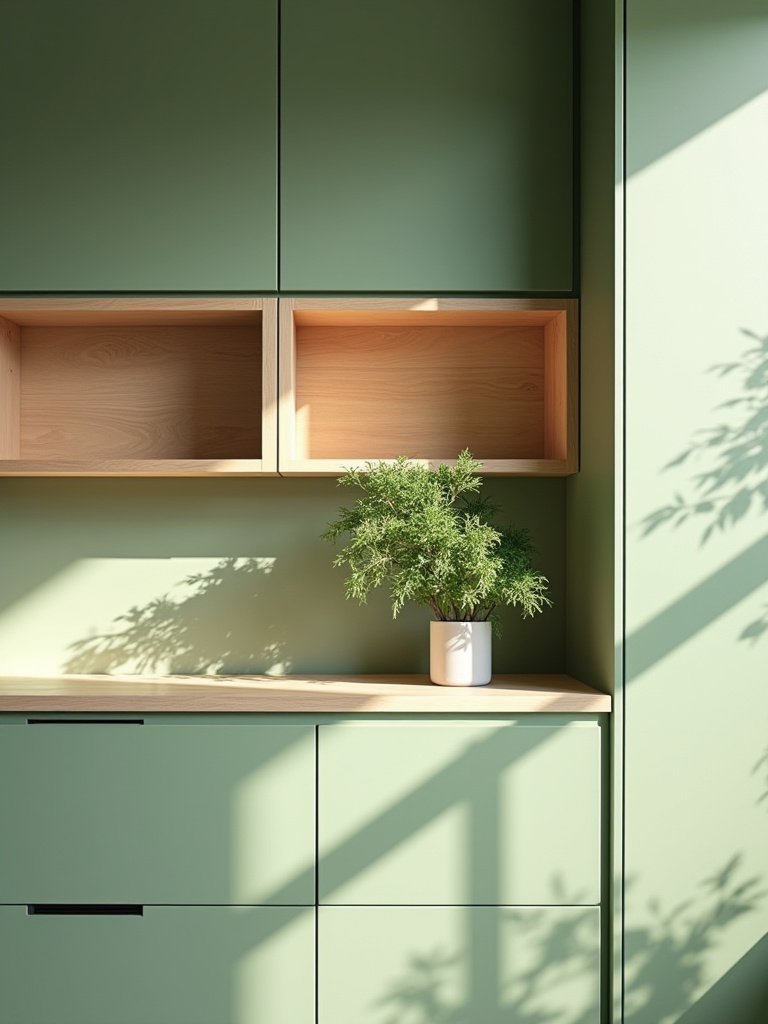
In my professional experience, there are also incredible engineered options that align with this ethos. Look for high-quality boards with low-VOC (volatile organic compound) content, made from recycled materials or fast-growing resources like bamboo. These aren’t just a compromise; they offer fantastic stability and a perfect canvas for our chosen green. Thinking about the intrinsic quality of these materials—their story, their impact—is the first step in creating a kitchen that is not only beautiful but also built on a foundation of integrity.
7. The Patina Palette: Navigating the Tactile and Visual Nuances of Finishes (Matte vs. Gloss vs. Textured)
Once you have your material, the finish becomes its voice. How will it speak to the room? A matte finish is like a soft, velvety whisper. It absorbs light, giving deep greens an incredible, profound depth and lighter greens a serene, muted quality. I love how it feels so calming and organic to the touch, and it beautifully masks the little fingerprints of daily life.
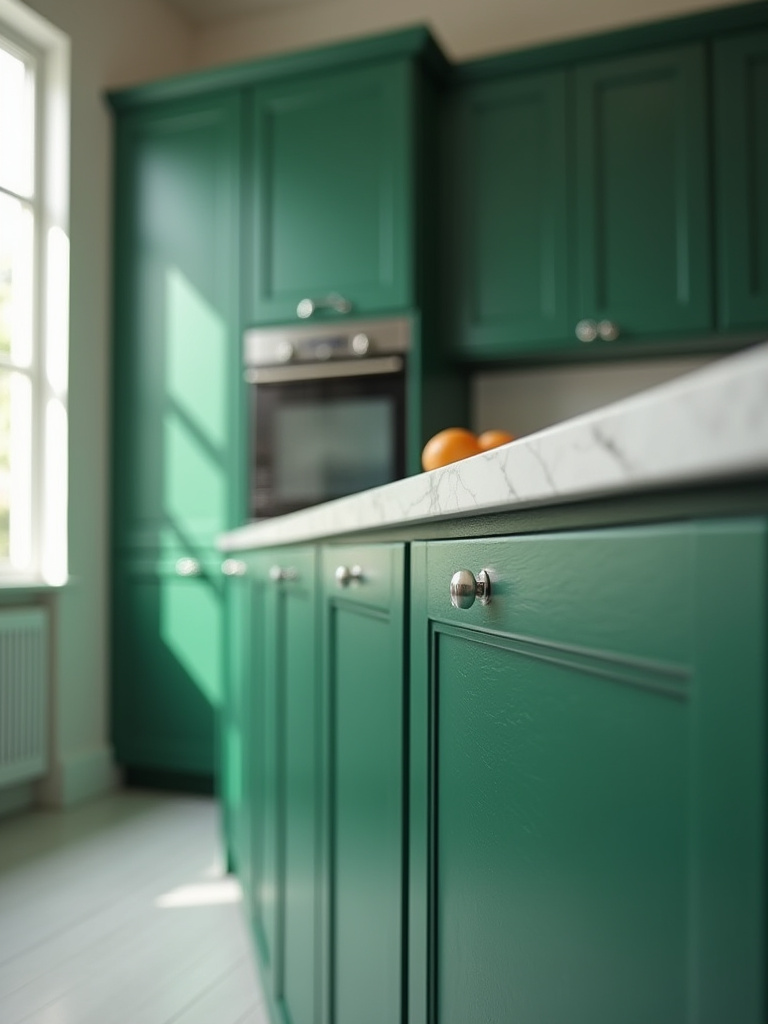
A gloss finish, on the other hand, is a joyful declaration! It reflects light, making your green feel vibrant and alive, almost like a lacquered jewel box. This can be magical in a smaller space, visually expanding it and adding a touch of contemporary glamour. Then there’s texture, which invites a conversation with your sense of touch. Imagine a subtle grain peeking through a wash of green, or a more pronounced linear texture. The finish is not just a protective layer; it’s what gives your green kitchen cabinets their final, distinct personality, bringing your whole design vision to life.
8. Precision in Praxis: The Crucial Role of Bespoke Joinery and Master Craftsmanship
The philosophy of mindful sourcing must extend to the hands that shape the wood. Bespoke joinery, custom-crafted for your space, is an art form that elevates your green kitchen cabinets from simple boxes to functional architecture. This is about honoring the material with masterful craftsmanship, ensuring longevity and minimizing waste. A true artisan understands the wood, using time-honored techniques like dovetail joints that are not only strong but beautiful in their own right.
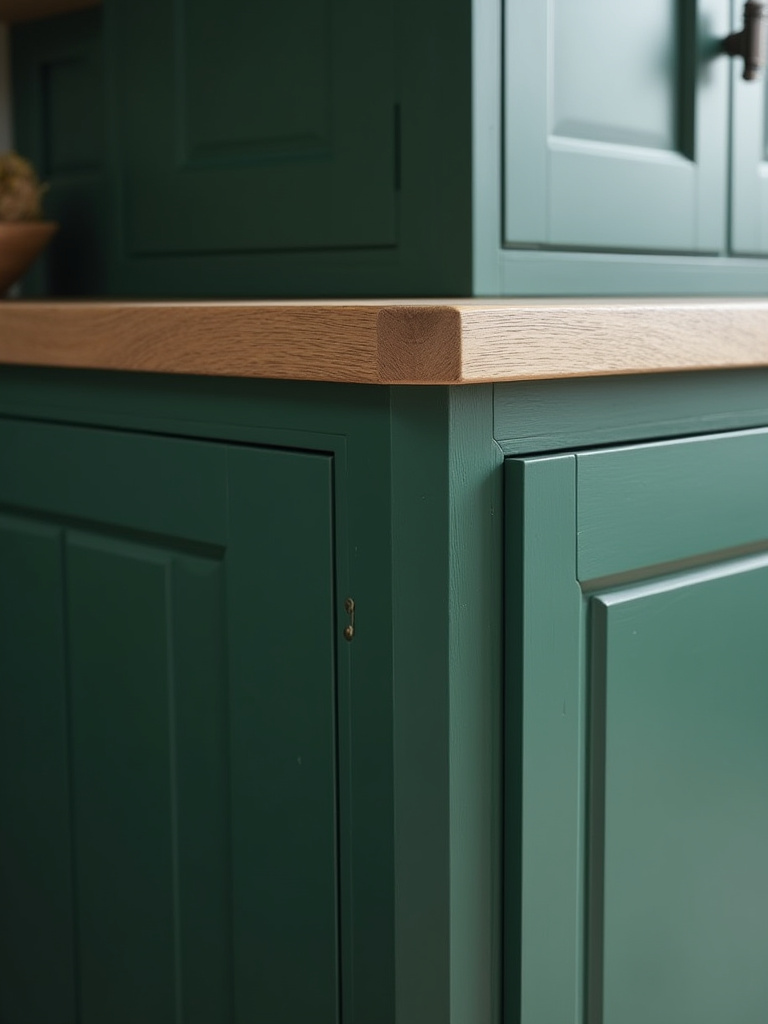
What really gets me is the difference in soul. Mass-produced cabinets can feel lifeless, but a piece made by a master craftsman holds a certain energy. They can create innovative solutions for tricky corners or unique storage that a factory line could never replicate. Years of Indian art integration have taught me to value this human touch. Engaging local artisans also supports your community and creates a kitchen built to become an heirloom, a testament to quality that will stand the test of time.
9. Harmonizing with Hardware: Selecting Aesthetically Complementary and Functionally Superior Fixtures
Hardware is the jewelry of your kitchen, the final touch that can completely define the character of your green kitchen cabinets. Every time you open a drawer, the feel of the handle contributes to your experience of the space. So choose fixtures that are not only beautiful but also feel substantial and joyful to use—solid brass, bronze, or even hand-forged iron.
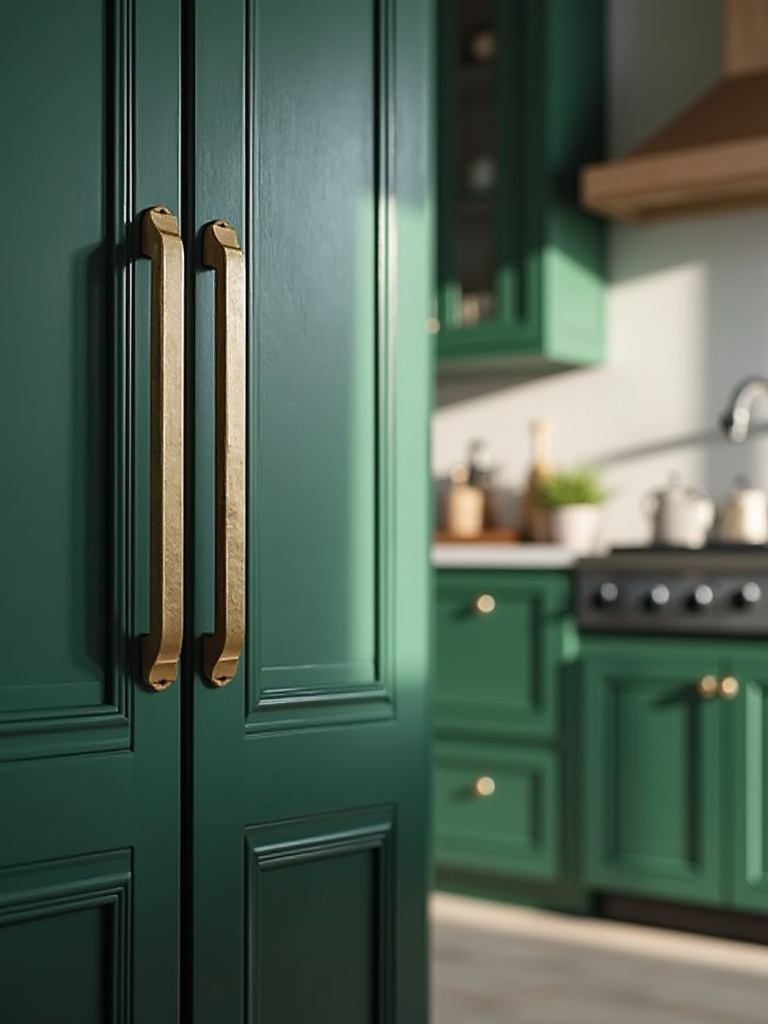
The aesthetic harmony is key. For deep, forest green cabinets, antique brass hardware glows with a warm, heritage feel. For a fresh, mint green, perhaps polished chrome adds a bright, contemporary sparkle. I love guiding clients to look beyond the expected. Think about artisanal ceramic knobs from Jaipur or handcrafted leather pulls. These unique touches are an expansion of your sustainable ethos, ensuring that every single detail of your kitchen, no matter how small, is infused with beauty, integrity, and soul.
Artisanal Greenscapes: Selecting Sustainable Materials and Finishes (Part 2)
Now let’s talk about the unsung hero of design: texture. It’s what transforms a space from something you just look at into something you experience. For your kitchen, texture adds depth, warmth, and a connection to the raw, natural beauty of the world. It’s the difference between a picture and a story.
10. Textural Topography: Integrating Intrinsic Grain Patterns and Applied Textures for Depth
Texture speaks a language that goes beyond what we see, inviting touch and adding a layer of soul to your space. With green kitchen cabinets as our canvas, we can create a rich textural landscape. Start by celebrating the intrinsic beauty of wood grain itself—the elegant cathedrals in oak, the subtle stripes of ash. Even a smooth, painted surface feels different when you know there is real wood beneath.
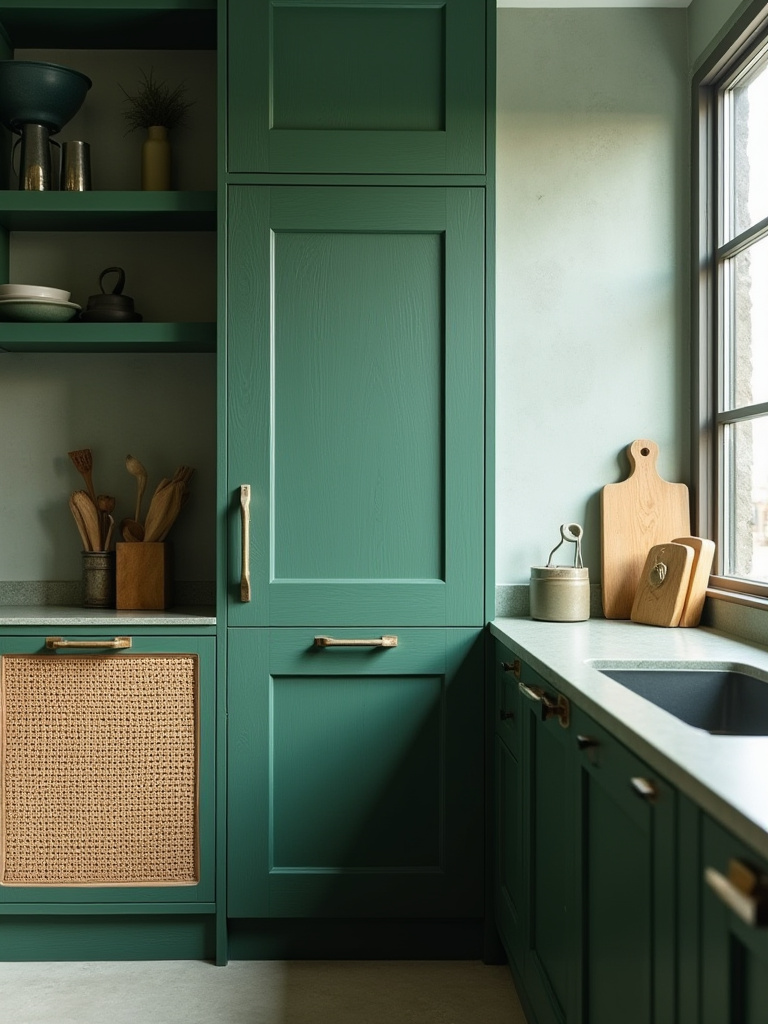
From my work in Indian art integration, I know how powerful a subtle texture can be. Applied textures can add another layer of depth. Think about a fluted or reeded panel on some of your cabinet doors, creating a beautiful play of light and shadow. The key is contrast. Imagine your smooth, matte green kitchen cabinets juxtaposed with the rustic honesty of a reclaimed wood open shelf. This interplay of smooth and rough, refined and raw, creates a dynamic, engaging kitchen where every surface tells a story and invites a connection. It’s a design you can truly feel.
Symphony of Space: Integrating Green Cabinetry within Architectural Narratives (Part 1)
Your green cabinets are the star of the show, but every star needs a brilliant supporting cast. This is where we orchestrate the rest of the space—the colors, the light, the surfaces—to create a breathtaking symphony where every element works in perfect harmony.
11. Chromatic Confluence: Orchestrating an Elemental Color Narrative Beyond the Cabinets
Your gorgeous green cabinets shouldn’t exist in isolation; they are the heart of a larger color story. Think of yourself as a composer, weaving a beautiful chromatic symphony around them. Start with your chosen green. Is it a warm, earthy olive? Then draw in other warm tones—creamy whites, terracotta accents, the golden glow of brass. Is it a cool, misty sage? Pair it with soft grays, natural woods, and perhaps a touch of muted blue.
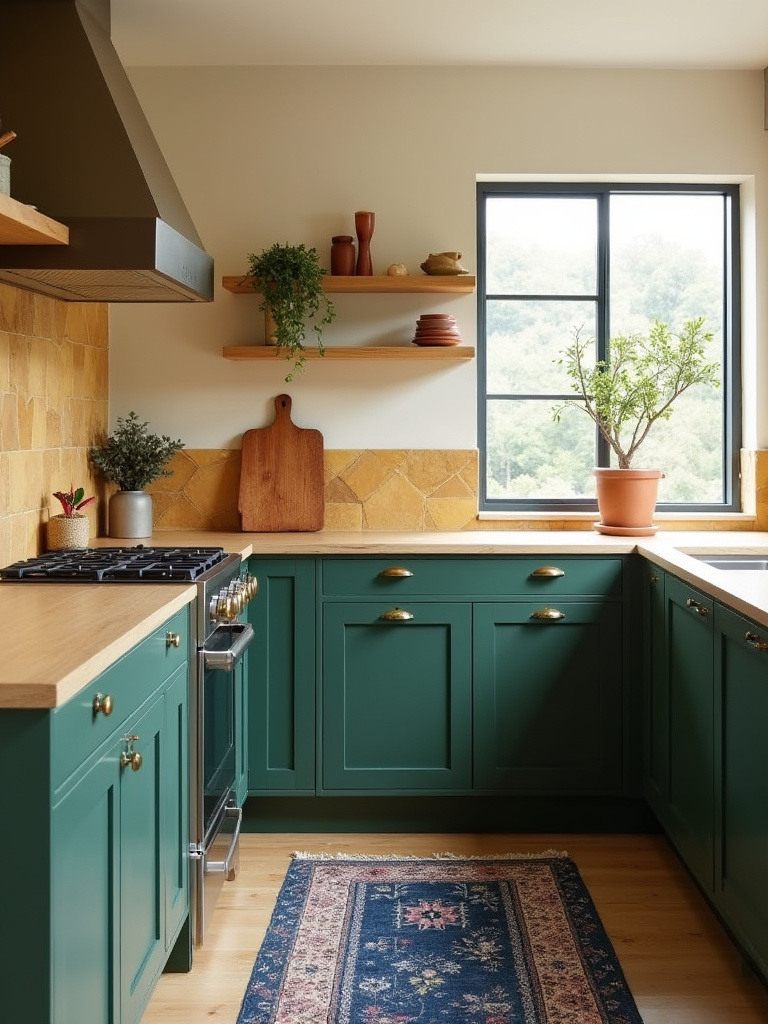
Stay with me here—this goes beyond paint. Consider the warm hue of your wooden floors, the subtle veining in your countertop, the colors in a beloved piece of art. Even the spices in your masala dabba can offer inspiration! Here’s what’s interesting: sometimes a single, deliberate pop of a complementary color, like a deep ruby red in a rug or bowl, can make your green kitchen cabinets feel even more vibrant and alive. The goal is to create a palette that feels cohesive, personal, and utterly harmonious.
12. Luminous Layering: Maximizing Natural and Curated Artificial Illumination for Verdant Revelation
Light is the magic that brings color to life. For your green kitchen cabinets, you need a thoughtful strategy that embraces both the sun’s natural poetry and the curated glow of artificial lighting. First, honor the natural light. Keep window treatments light and airy to let the daylight flood in and watch how it transforms the nuances of your green throughout the day. This is the living, breathing element of your design.
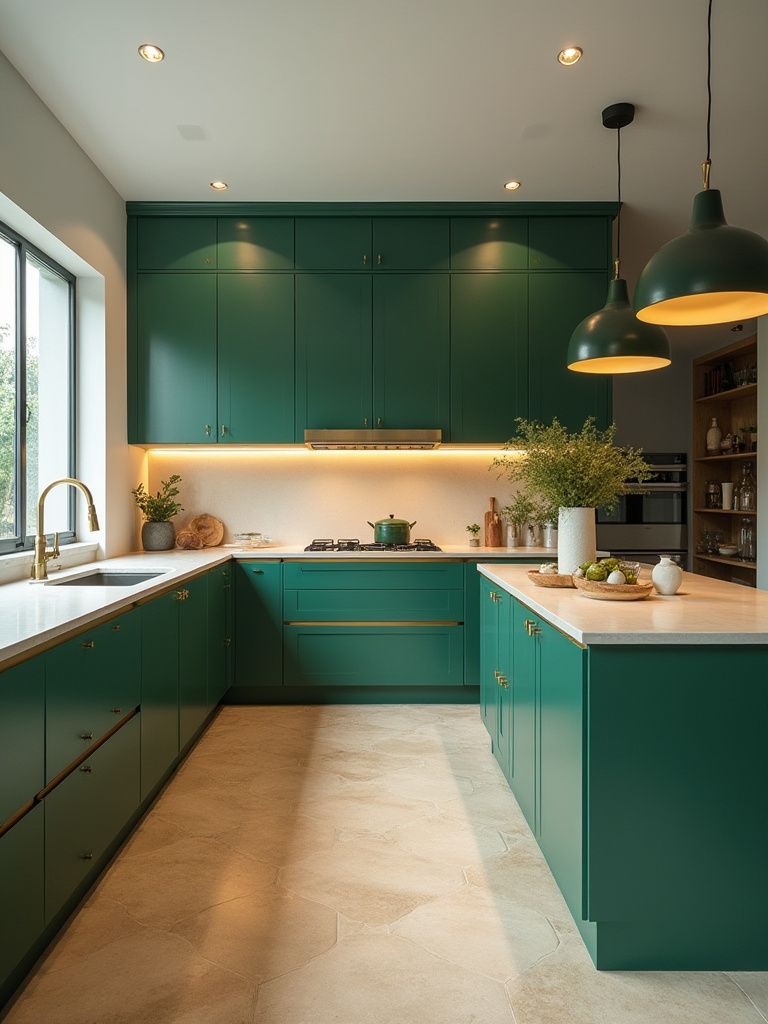
Then, layer your artificial light with intention. Ambient light, like recessed ceiling lights, provides the overall glow. Next comes task lighting—this part is important. Under-cabinet strips are non-negotiable, as they eliminate shadows on your work surfaces and beautifully illuminate the finish of your cabinets. Finally, add accent lighting. This is the sparkle! A beautiful pendant over your island or a delicate sconce can act as a piece of jewelry, creating mood, drama, and a warm, inviting welcome. With the right light, your kitchen doesn’t just function; it glows.
13. Counterpoint Countertops: Strategically Pairing Surfaces to Accentuate Green Cabinetry’s Vibrancy
The countertop is your cabinet’s closest partner, and their relationship is key to the success of your kitchen’s design. The right pairing can make your green kitchen cabinets sing. For a dramatic and elegant statement, imagine deep forest green cabinets crowned with a crisp white marble or quartz. The clean, bright contrast is timeless and sophisticated, allowing the rich green to be the undisputed hero.
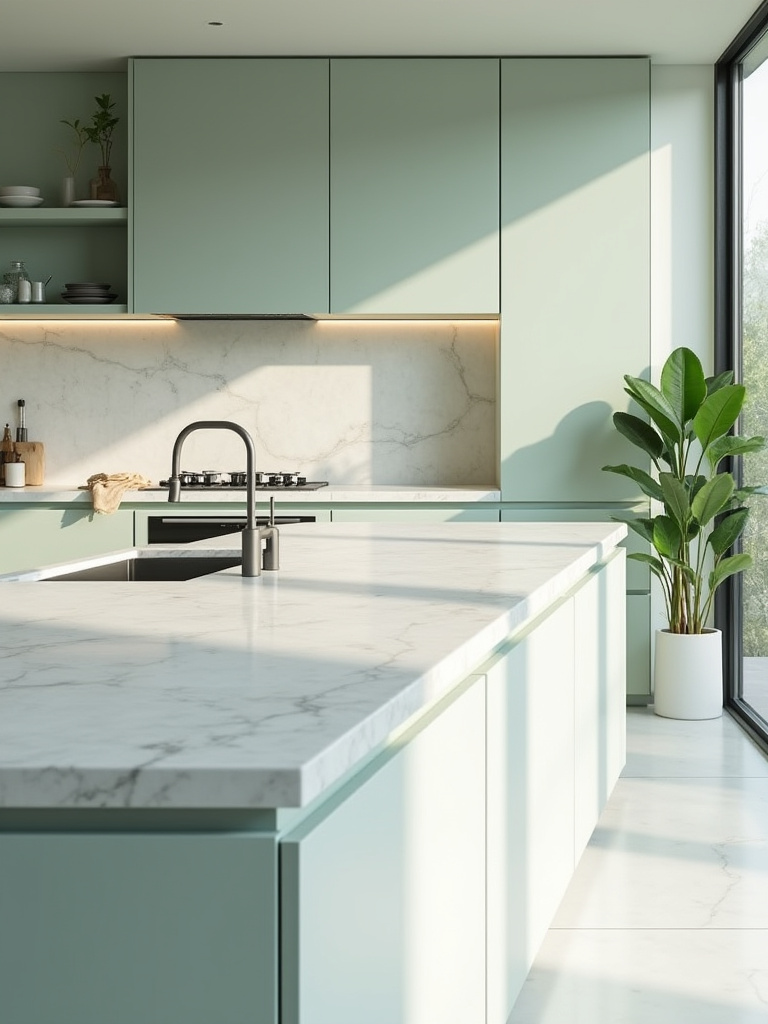
But contrast isn’t the only story to tell. For a warmer, more organic feel, pair a soft sage green cabinet with a butcher block countertop. The natural wood grain and the gentle green create a soothing, biophilic harmony that feels incredibly grounding. In my professional experience, materials with subtle movement, like a quartzite with soft, warm veining, can be magical. The subtle colors in the stone can tie together the green cabinets with other elements in the room, creating a design that feels deeply considered and effortlessly beautiful.
14. Pattern Prose: Introducing Culturally Rich Textiles and Tilework to Elevate the Green Palette
This is where we add the poetry! Pattern brings soul, story, and a layer of artisanal beauty to your space. With green kitchen cabinets as your calm, solid foundation, you have the perfect canvas to introduce pattern through rich textiles and expressive tilework. Imagine a hand-blocked printed runner on the floor, its intricate motifs telling a story of Rajasthani craft, or sheer cafe curtains with delicate Chikankari embroidery filtering the morning light.
Tile is your opportunity for a more permanent expression of pattern. A backsplash of handmade Zellige tiles, with their perfectly imperfect surfaces and subtle color variations, adds a luminous, textural quality that beautifully complements green. Or perhaps a bold, geometric cement tile floor can act as a stunning anchor for the entire room. What I tell my clients is that pattern is a way to infuse your personality and heritage into the space, creating a dialogue between the clean lines of modern cabinetry and the soulful touch of the human hand.
Symphony of Space: Integrating Green Cabinetry within Architectural Narratives (Part 2)
A kitchen, especially a vibrant green one, should never feel like an island. It should feel connected, part of a seamless flow that enhances your entire living space. This section is about creating that beautiful continuity, ensuring the heart of your home beats in rhythm with the rest of your sanctuary.
15. Curating Continuum: Ensuring Seamless Visual Transition Between Kitchen and Adjacent Living Zones
In modern homes, the kitchen flows into living and dining areas, creating one large, connected heart of the home. To make this work beautifully, the design language must flow, too. Your green kitchen cabinets are a strong statement, and the secret is to let them whisper echoes of their color and feel into the adjoining spaces, creating a harmonious continuum rather than an abrupt stop.
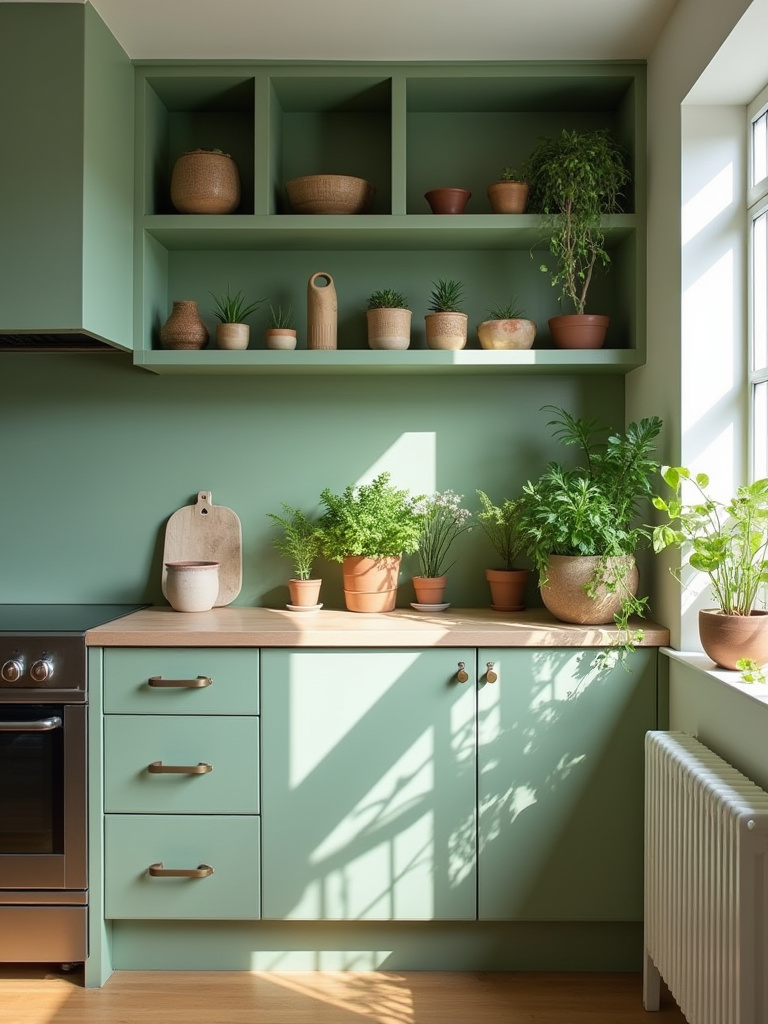
This is achieved through thoughtful threads of connection. Perhaps a soft, sage green from your cabinets is picked up in the pattern of the living room throw pillows. The warm brass of your kitchen hardware might be mirrored in a picture frame or the base of a lamp nearby. Texture also plays a key role. The matte finish on your cabinets could be echoed in a plush velvet armchair, creating a tactile link between the zones.
This isn’t about matching everything perfectly. Actually, let me back up. It’s about creating a cohesive conversation. You can extend the kitchen’s wood flooring into the living area to physically and visually unite the spaces. Or perhaps a fluted detail on your cabinet doors is subtly repeated on a sideboard in the dining area. What I’ve seen in my Indo-Contemporary fusion practice is that these subtle connections are what make an open-plan space feel intentional, expansive, and deeply calming.
Ultimately, curating this continuum creates a home that feels intuitive and whole. The grounded, serene energy of your green kitchen cabinets extends its influence, creating a unified sanctuary that supports all aspects of your life, from cooking and eating to relaxing and connecting. Your home begins to breathe as one beautiful, harmonious entity.
Curated Continuity: Maintaining and Evolving Your Verdant Culinary Sanctuary (Part 1)
Your beautiful kitchen is complete, but this is just the beginning of your relationship with it. A true sanctuary is a living space, one that is cared for and evolves with you. Here we’ll talk about the art of stewardship—how to nurture your kitchen so it remains beautiful for years, and how to allow it to adapt and grow.
16. Nurturing the Hue: Establishing a Regime for Prolonging Green Cabinetry’s Aesthetic Integrity
The deep, rich color of your new green kitchen cabinets is a thing of beauty, and nurturing that hue is an act of love and respect for the craftsmanship involved. Think of it not as cleaning, but as stewardship. The key is gentle, consistent care. Forget harsh chemical cleaners; they can strip the life right out of the finish. A soft, damp microfiber cloth is your best friend for daily care.
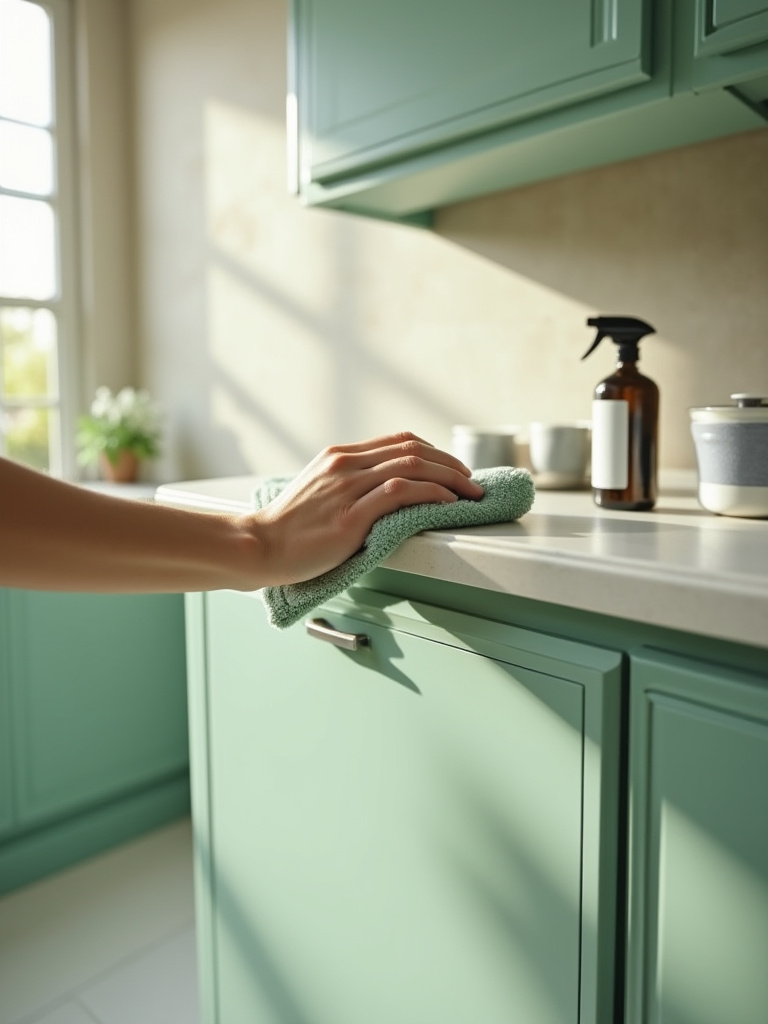
For a deeper clean, a simple solution of mild, eco-friendly soap and water is all you need. What’s most important is understanding the specific finish of your cabinets. A natural oiled wood will occasionally need a fresh coat of oil to nourish it and deepen its luster—a beautiful ritual that reconnects you with the raw material. By establishing this simple, mindful regime, you ensure the aesthetic integrity of your cabinets, allowing them to mature gracefully and develop a rich patina over time, telling the story of your life lived well within them.
17. Future-Forward Flora: Anticipating Design Trends and Incorporating Adaptable Elements
One of the most wonderful things about choosing a timeless color like green is its incredible adaptability. Your green kitchen cabinets are a strong, classic anchor, giving you the freedom to play with evolving trends without ever needing a major overhaul. The secret is to keep your core elements timeless and allow your accent pieces to be more fluid.
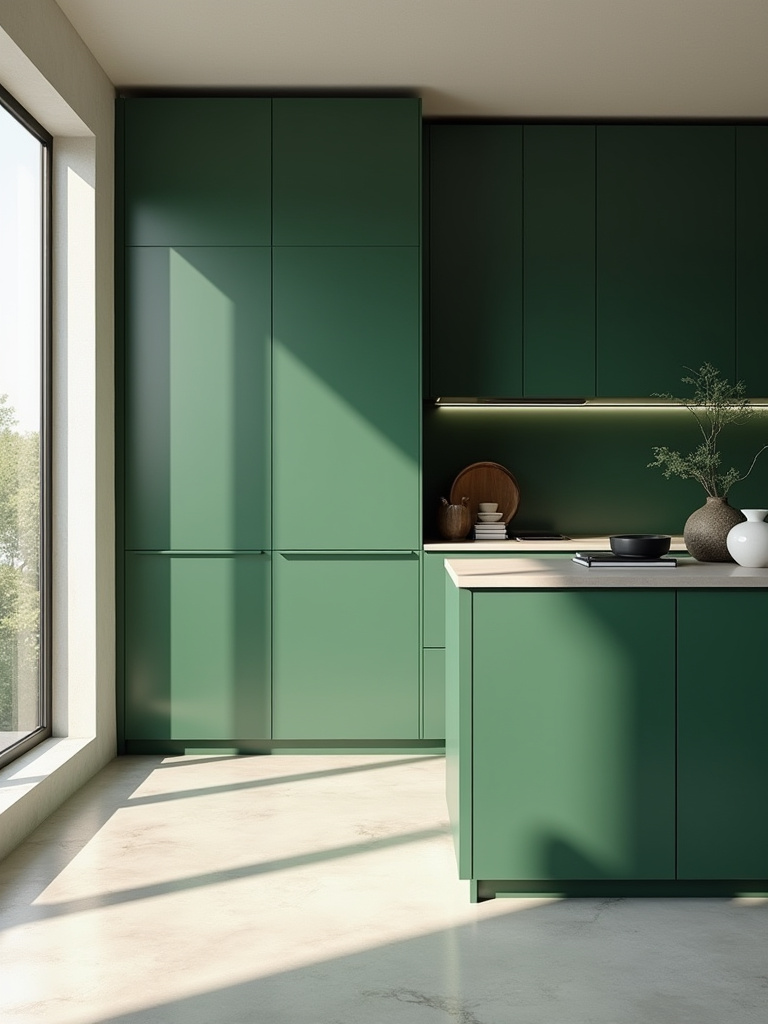
Hardware is the easiest and most impactful element to change. Swapping out simple pulls for artisanal ceramic knobs or sleek brass handles can completely shift the mood of your kitchen in an afternoon. open shelving is another brilliant, adaptable element. Here you can rotate displays of pottery, glassware, or cookbooks to reflect new colors or seasonal moods. Your green cabinets provide the perfect, serene backdrop for these little moments of evolving style, ensuring your kitchen feels both enduringly elegant and perfectly current.
18. The Artisanal Afterthought: Thoughtful Display of Collectibles and Botanicals
Now we infuse the space with your unique spirit. The “artisanal afterthought” is the art of curating the objects and living things that make a kitchen uniquely yours. Against the backdrop of your serene green kitchen cabinets, every single object gains presence. This is where you display your grandmother’s beloved brass mortar and pestle, a piece of pottery you found on your travels, or a collection of beautifully worn wooden cutting boards.
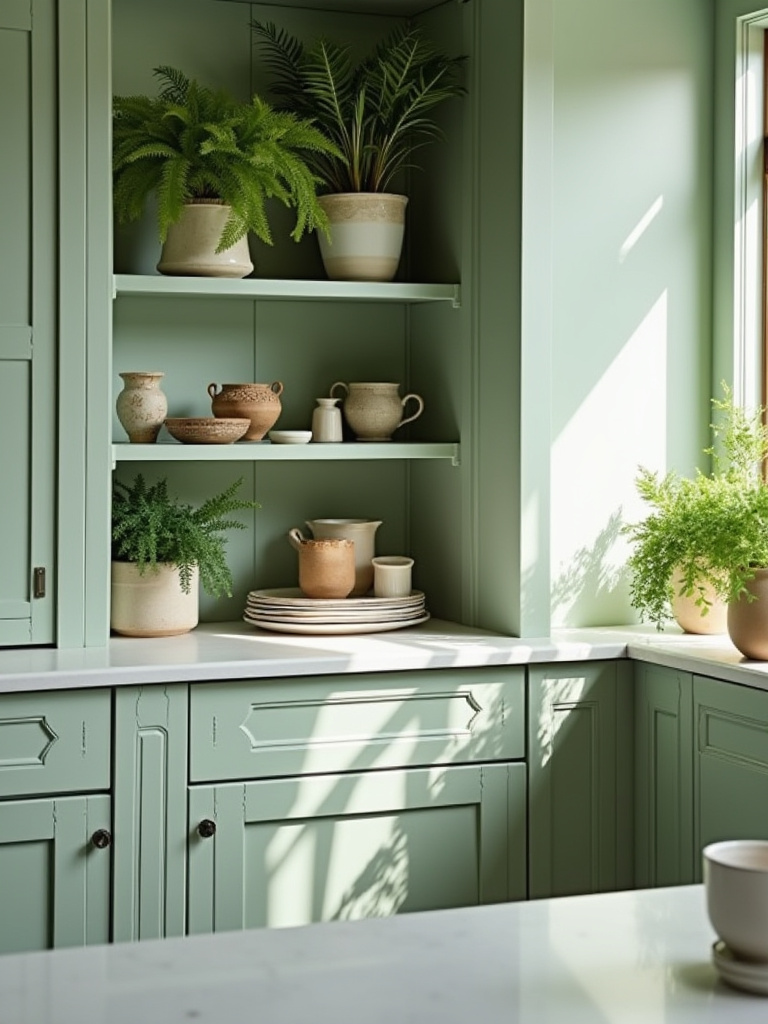
Living plants are essential. They are the breathing embodiment of the green in your cabinetry. Think beyond a simple pot of herbs and consider a sculptural fiddle-leaf fig in a terracotta pot, or delicate tendrils of a pothos trailing from an upper shelf. These botanical elements create a vital link to the natural world. I learned this when I realized the most soulful spaces I designed always had this layer of personal story and living beauty. Your kitchen transforms from a pristine design into a warm, inviting gallery of your life.
19. Mitigating Mismeasures: Avoiding Common Pitfalls in Green Kitchen Cabinet Maintenance and Stylization
Even with the best intentions, a few common missteps can dull the magic of your new kitchen. The biggest one in maintenance is using the wrong cleaner. All-purpose sprays are often too harsh and can damage delicate paint finishes over time. Always use a gentle, pH-neutral cleaner. Another pitfall is letting grease and grime build up, especially near the stove. A quick daily wipe-down is far easier and more effective than a heavy scrub later on.
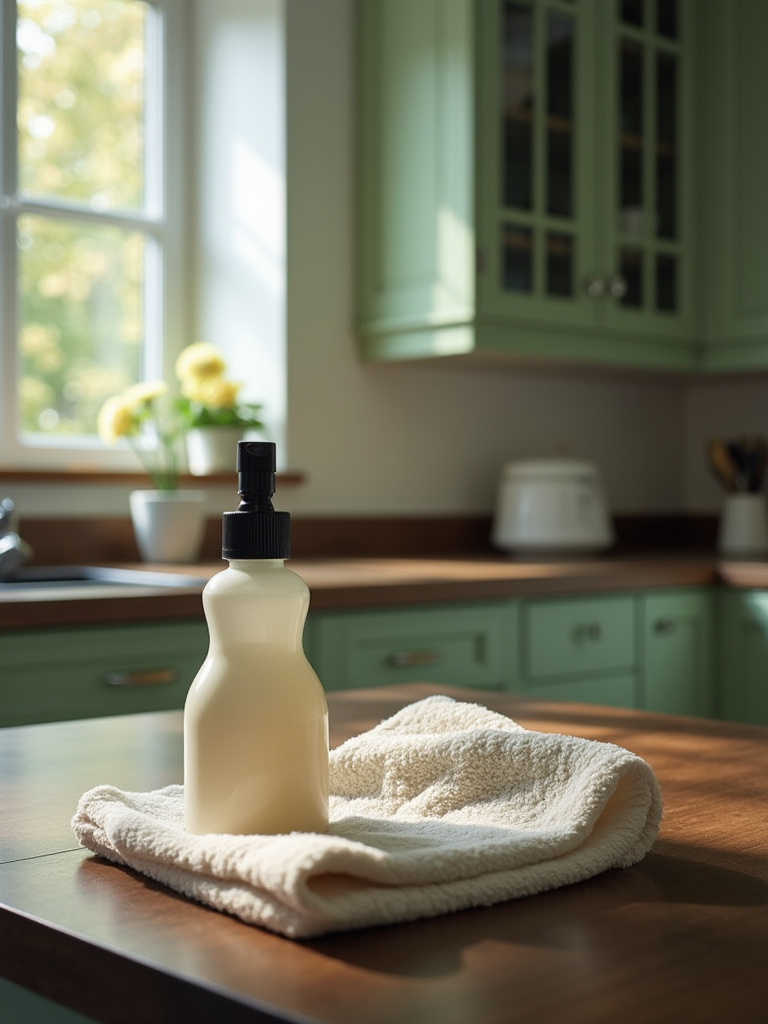
Stylistically, the most common mismeasure is clutter. Your green cabinets provide a calm foundation; don’t overwhelm them with too many competing accessories. Give your beautiful, curated objects space to breathe. Also, pay attention to your lighting. Poor lighting can make even the most stunning shade of green look drab. A layered lighting plan is crucial. By avoiding these common errors, you protect your investment and ensure your verdant sanctuary remains a place of harmony and beauty for years to come.
Curated Continuity: Maintaining and Evolving Your Verdant Culinary Sanctuary (Part 2)
Your kitchen is a living part of your home, and its beauty can be renewed with the changing seasons. This is about embracing the subtle art of ephemeral enhancements, allowing your sanctuary to feel connected to the natural rhythms of life outside your door. It’s a joyful practice that keeps your space feeling fresh, alive, and ever-inspiring.
20. Ephemeral Enhancements: Infusing Seasonal Allusions and Ephemeral Decor into Your Verdant Palette
A truly vibrant home breathes with the seasons, and your kitchen, anchored by its steadfast green kitchen cabinets, is the perfect stage for this beautiful, unfolding story. This philosophy is about embracing the beauty of the temporary—the ephemeral enhancements that connect your indoor sanctuary with the world outside. It’s about marking the passage of time not just on a calendar, but with your senses.
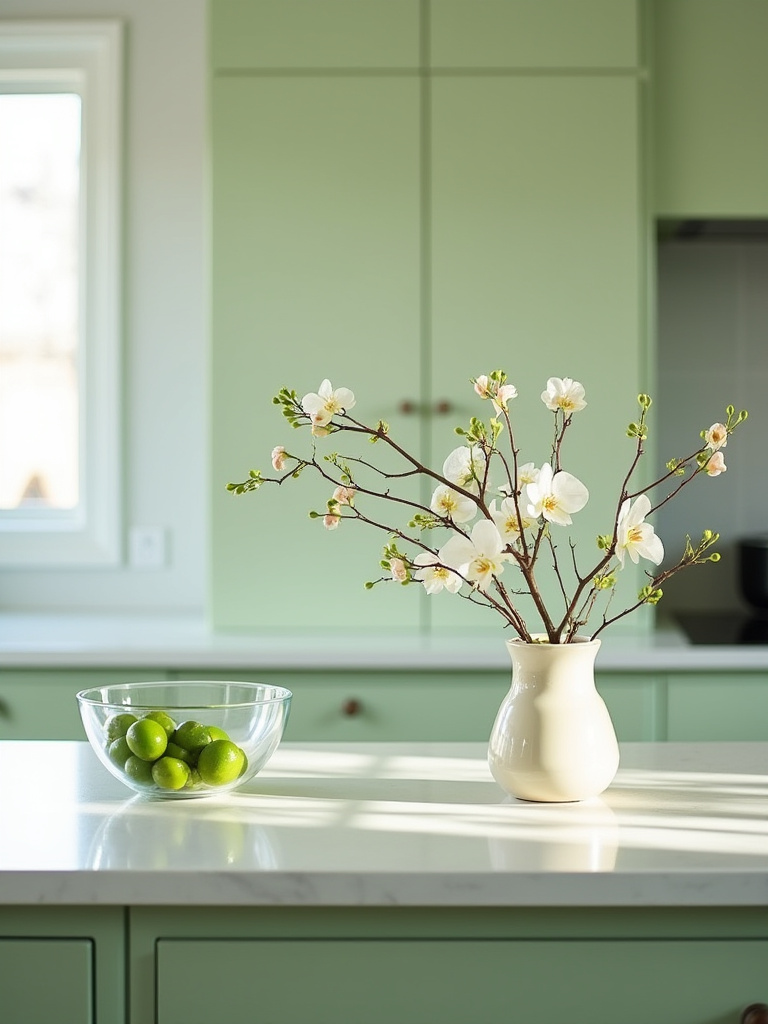
Imagine, in the depths of winter, a simple branch of scarlet berries in a ceramic vase, a stark and beautiful contrast against your deep green cabinets. In spring, a bowl overflowing with lemons or a pitcher filled with fresh tulips can bring a burst of sunshine and life. During festive times like Diwali, bowls of marigolds and softly glowing brass diyas can add a sacred, celebratory warmth. These aren’t permanent fixtures; they are transient moments of beauty that keep your kitchen feeling dynamic and alive.
The application is simple and joyful. Your island or countertop becomes a canvas for these seasonal vignettes. A rotation of hand-spun linen tea towels, a small piece of seasonal art leaned against the backsplash, or even a beautiful display of heirloom produce from the market can shift the entire mood of the room. This practice transforms the act of “decorating” into a mindful ritual of connection.
Ultimately, this constant, gentle evolution deepens your relationship with your home. It’s a way of celebrating the present moment, acknowledging the beauty of nature’s cycles. Your enduring green kitchen cabinets provide the perfect, grounding canvas for this play of temporary beauty, creating a space that feels not just designed, but deeply and soulfully lived-in, day after day, season after season.
Conclusion
Our journey through these twenty principles has shown us that choosing green kitchen cabinets is so much more than a design decision; it is the beginning of a story. We’ve moved from the psychology of color to the integrity of materials and the symphony of space, discovering how every choice can contribute to a kitchen that is not just beautiful, but soulful. You have laid a foundation for a space that is a true sanctuary—the verdant, beating heart of your home.
You are now wonderfully equipped to create this reality. Remember that your kitchen is a reflection of your values, a canvas for your heritage, and a space for daily joy. I encourage you not just to decorate, but to compose your space with intention, weaving in your own stories and aspirations. Let these verdant hues be the beginning of a kitchen that nourishes your family and your spirit in equal measure. Embrace this vision with a bold and joyful heart, and watch your sanctuary blossom.
